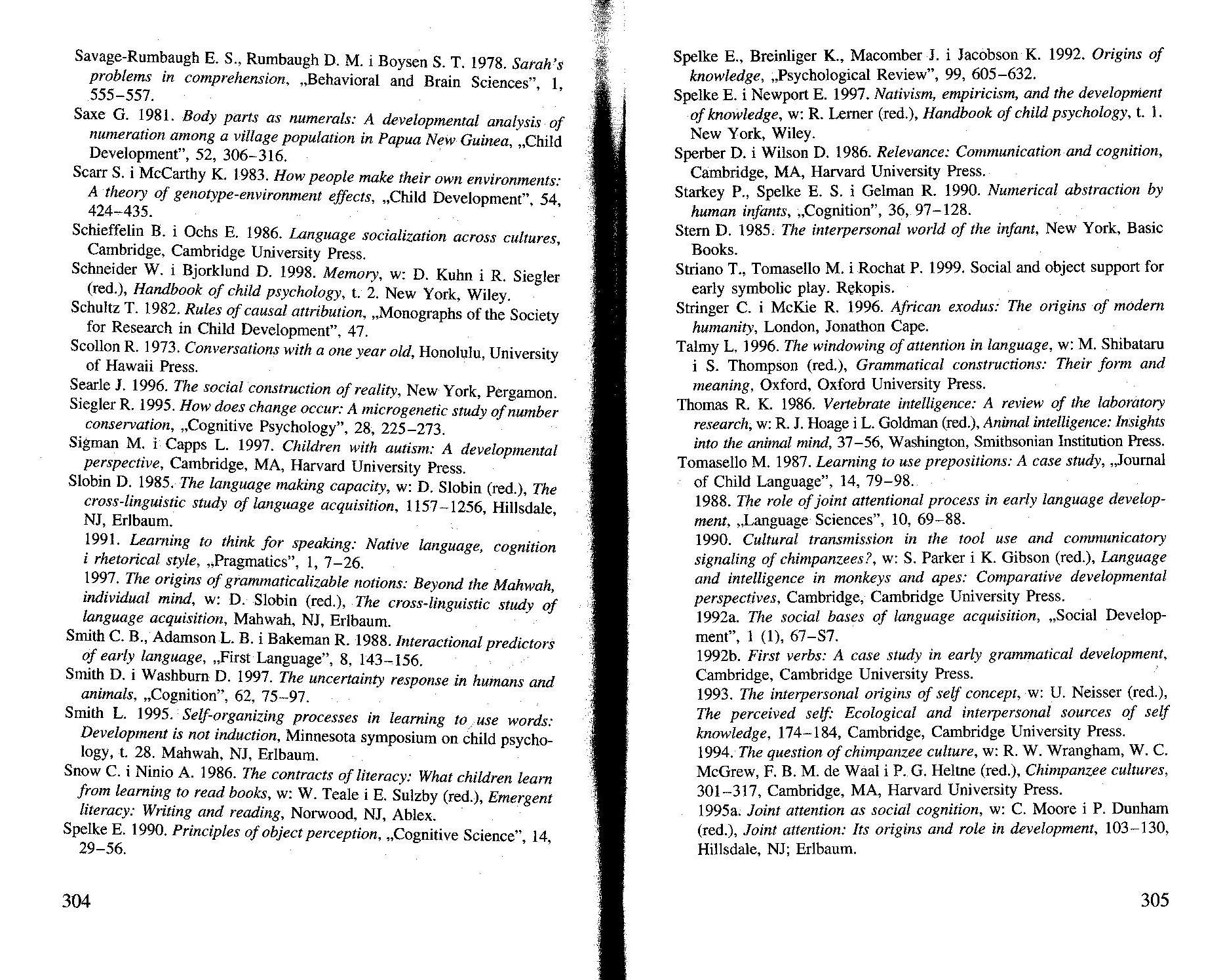CCF20090212�151

Savage-Rumbaugh E. S., Rumbaugh D. M. i Boysen S. T. 1978. Sarah’s problems in comprehension, „Behavioral and Brain Sciences”, 1, 555-557.
Saxe G. 1981. Body parts as numerals: A developmental analysis of numeration among a village population in Papua New Guinea, „Child Development”, 52, 306-316.
Scarr S. i McCarthy K. 1983. How people make their own environments: A theory of genotype-environment ejfecłs, „Child Development”, 54, 424-435.
Schieffelin B. i Ochs E. 1986. Language socialization across cultures, Cambridge, Cambridge University Press.
Schneider W. i Bjorklund D. 1998. Memory, w: D. Kuhn i R. Siegler (red.), Handbook of child psychology, t. 2. New York, Wiley.
Schultz T. 1982. Rules ofcausal attribution, „Monographs of the Society for Research in Child Development”, 47.
Scollon R. 1973. Conversations with a one year old, Honolulu, University of Hawaii Press.
Searle J. 1996. The social construction ofreality, New York, Pergamon.
Siegler R. 1995. How does change occur: A microgenełic study ofnumber conservation, „Cognitive Psychology”, 28, 225-273.
Sigman M. i Capps L. 1997. Children with autism: A developmental perspective, Cambridge, MA, Harvard University Press.
Slobin D. 1985. The language making capacity, w: D. Slobin (red.), The cross-linguistic study of language acąuisition, 1157-1256, Hillsdale, NJ, Erlbaum.
1991. Leaming to think for speaking: Native language, cognition i rhetorical style, „Pragmatics”, 1, 7-26.
1997. The origins of grammaticalizable notions: Beyond the Mahwah, indmdual mind, w: D. Slobin (red.), The cross-linguistic study of language acąuisition, Mahwah, NJ, Erlbaum.
Smith C. B., Adamson L. B. i Bakeman R. 1988. Interactional predictors of early language, „First Language”, 8, 143-156.
Smith D. i Washbum D. 1997. The uncertainty response in humans and animals, „Cognition”, 62, 75-97.
Smith L. 1995. Self-organizing processes in leaming to use words: Development is not induction, Minnesota symposium on child psychology, t. 28. Mahwah, NJ, Erlbaum.
Snów C. i Ninio A. 1986. The contracts ofliteracy: What children leam from learning to read books, w: W. Teale i E. Sulzby (red,), Emergent literacy: Writing and reading, Norwood, NJ, Ablex.
Spelke E. 1990. Principles of object perception, „Cognitive Science”, 14, 29-56.
Spelke E., Breinliger K., Macomber J. i Jacobson K. 1992. Origins of knowłedge, „Psychological Review”, 99, 605-632.
Spelke E. i Newport E. 1997. Natmsm, empiricism, and the development of knowłedge, w: R. Lemer (red.), Handbook of child psychology, t. 1. New York, Wiley.
Sperber D. i Wilson D. 1986. Relevance: Communication and cognition, Cambridge, MA, Harvard University Press.
Starkey P., Spelke E. S. i Gelman R. 1990. Numerical abstraction by human infants, „Cognition”, 36, 97-128.
Stern D. 1985. The interpersonal world of the infant, New York, Basic Books.
Striano T., Tomasello M. i Rochat P. 1999. Social and object support for early symbolic play. Rękopis.
Stringer C. i McKie R. 1996. African exodus: The origins of modem humanity, London, Jonathon Cape.
Taimy L. 1996. The windowing of attention in language, w: M. Shibataru i S. Thompson (red.), Grammatical constructions: Their form and meaning, Oxford, Oxford University Press.
Thomas R. K. 1986. Vertebrate intelłigence: A review of the laboratory research, w: R. J. Hoage i L. Goldman (red.), Animal intelłigence: Insights into the animal mind, 37-56, Washington, Smithsonian Institution Press. Tomasello M. 1987. Learning to use prepositions: A case study, „Journal of Child Language”, 14, 79-98.
1988. The role of joint attentional process in early language develop-ment, „Language Sciences”, 10, 69-88.
1990. Cultural transmission in the tool use and communicatory signaling of chimpanzees?, w: S. Parker i K. Gibson (red.), Language and intelłigence in monkeys and apes: Comparative developmental perspectives, Cambridge, Cambridge University Press.
1992a. The social bases of language acauisition, „Social Develop-ment”, 1 (1), 67-S7.
1992b. First verbs: A case study in early grammatical development, Cambridge, Cambridge University Press.
1993. The interpersonal origins of self concept, w: U. Neisser (red.), The perceived self: Ecological and interpersonal sources of self knowłedge, 174-184, Cambridge, Cambridge University Press.
1994. The guestion of chimpanzee culture, w: R. W. Wrangham, W. C. McGrew, F. B. M. de Waal i P. G. Heltne (red.), Chimpanzee cultures, 301-317, Cambridge, MA, Harvard University Press.
1995a. Joint attention as social cognition, w: C. Moore i P. Dunham (red.), Joint attention: Its origins and role in development, 103-130, Hillsdale, NJ; Erlbaum.
305
Wyszukiwarka
Podobne podstrony:
250 251 (5) 250 Indeks nazwisk Sapir 60 Saunders 47 Savage-Rumbaugh 208 Schlosberg 23, 66, 78, 89, 9
CCF20090523�022 tif KARL R. POPPER Tak więc twierdzenia, problemy i rzecz jasna argumentacje, które
CCF20061214�075 POLECAMY PORADNIKI • „Encyklopedia władz spółek” Tom I - Problemy
CCF20081129�058 przekształciła się ona w wypowiedź; z drugiej strony problem i tak nie leży w przycz
CCF20081206�048 10.4. Podejmowanie decyzji Typowe rozwiązania typowych problemów Decyzje, które musi
CCF20081215�000 356Józef Kozielecki ślający najskuteczniejszą metodę rozwiązywania problemów. Tak wi
CCF20090303�037 78 Argument na rzecz indeterminizmu postawić problem wyjaśnialności na wyższym pozio
LastScan44 Według D. Levinsona (1978) istotnym problemem ludzi we wczesnej dorosłości jest obarczone
New Areas in the Diagnosis of Social Problems in Social Assistance Małgorzata Porąbaniec Wykluczenie
ggAn Introduction to Modern English Word-Formation ^ Areał Diffusion and Genetic Inheritance Problem
TRIBOLOGY SCIENTIFIC PROBLEMS OF MACHINES OPERATION AND MA1NTENANCE_ 3 (159)2009 ZBIGNIEW KŁOS*First
Agnieszka KRAWCZYK-SOŁTYS The main problem in implementation of the knowledge management system, in
meeting agenda, explaining the problem to the class, and then facilitating discussion via the applic
226 Przemysław Śleszyński Rees J., 1978, Manufacturing headąuarters in a postindustńal conext,
64A. T. Jankowski Rogoż M., Różkowski A., Wilk Z., 1987, Hydrogeologie problems in the Upper Silesia
więcej podobnych podstron